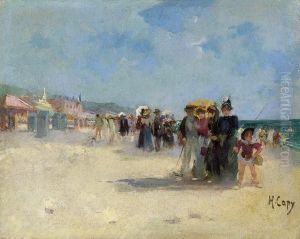Marcel Amable Capy Paintings
Marcel Amable Capy was a French artist born in 1874, whose work spanned from the late 19th century into the mid-20th century. Although not as widely recognized as some of his contemporaries, Capy's contributions to the art world, particularly through his illustrations, paintings, and engravings, have garnered appreciation for their unique style and perspective. His artistic journey reflects the transitions and turmoils of the era he lived in, from the Belle Époque through two World Wars and into the aftermath of the Second World War, before his death in 1951.
Capy's artwork often depicted scenes from everyday life, landscapes, and the working class, imbued with a sense of realism and sensitivity towards his subjects. This focus mirrored the broader artistic movements of his time, including Realism and later, elements of Impressionism. Despite not aligning strictly with any single art movement, Capy carved out his niche, showcasing his ability to capture the essence of his subjects with both empathy and precision. His engravings and illustrations became popular in various publications, allowing his work to reach a wider audience beyond the confines of galleries and the elite art world.
Throughout his career, Marcel Amable Capy engaged with the artistic community, contributing to the cultural landscape of France during a period of significant change. His works were exhibited in several salons and galleries, earning him recognition amongst his peers. However, the tumultuous times, particularly the impact of the World Wars, influenced his artistic output and themes, reflecting the broader societal shifts and the personal impact of these global events.
After his death in 1951, Capy's work continued to be celebrated for its historical value and artistic merit. While he may not have achieved the same level of fame as some of his contemporaries, his contributions provide a window into the life and times of the era he lived through, offering insights into the social and cultural dynamics of early to mid-20th century France. His legacy lives on through his art, which remains a testament to his skill, perspective, and the indelible mark he left on the world of French art.
